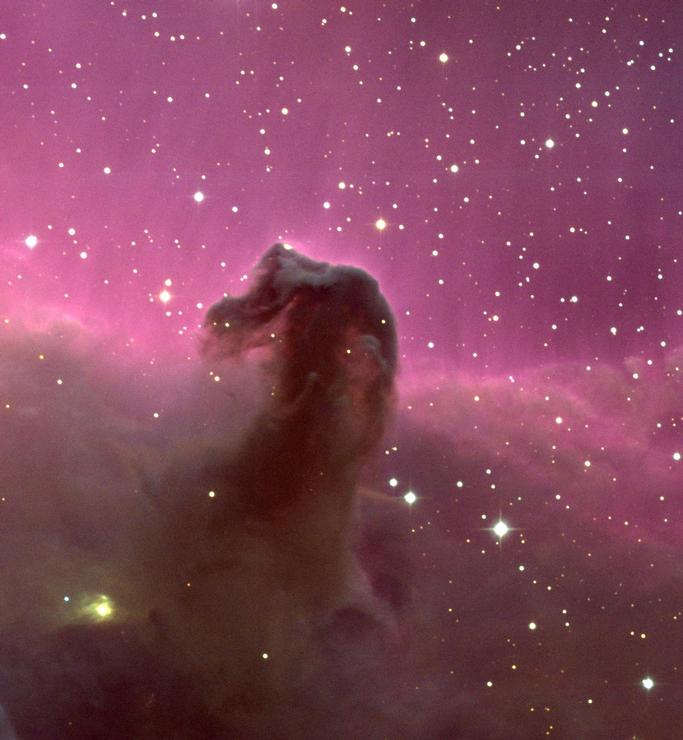
Image courtesy of Nigel Sharp (NOAO), NSF.
Caption: Dust in the Horsehead Nebula blocks light from stars behind it.
 Copyright © Michael Richmond.
This work is licensed under a Creative Commons License.
Copyright © Michael Richmond.
This work is licensed under a Creative Commons License.
Astronomers interested in star formation have devised several methods to identify very young stars. Very massive stars live very short lives: less than 10 million years for a star of 20 solar masses. Any high-mass star we see cannot be very old, and must still be close to its place of birth. Low-mass stars in their youth display a set of distinguishing characteristics: spectra with bright emission lines, circumstellar disks, the emission of X-rays, and certain types of variability. Over the years, we have used these markers to identify thousands of stars with ages under ten million years. Even a quick glance at the properties of young stars reveals two main facts. First, young stars are never found in isolation, but always in large groups. Second, these groups are always close to large clouds of molecular gas. Astronomers conclude that stars are formed in clusters from the gas in molecular clouds.
Molecular clouds are formed primarily of hydrogen, in the molecular phase H2. Note to editor: this should be "H with a subscript 2" Unfortunately for astronomers on Earth, hydrogen molecules are notoriously secretive. They don't interact with light in the visible part of the spectrum, so we can't see them directly with our optical telescopes. Even in other regions of the electromagnetic spectrum, they don't emit or absorb much radation under the conditions inside a cloud. How, then, can we detect these clouds? In fact, how do we know they exist at all?
The answer is to rely on tracers, materials which make up only a small portion of a cloud, but which are easy to detect. We use tracers in ordinary life, too. For example, television executives want to know who's watching which television programs. They can't afford to ask directly the hundreds of millions of viewers, so they take an indirect approach: they pick a few thousand individuals and families and study their viewing habits. These households act as "tracers" for the entire population: if 30% of them watch a particular program, odds are that roughly 30% of everyone is watching it.
Astronomers use several kinds of tracers when studying molecular clouds. Dust particles, which are often embedded in clouds of gas, reveal themselves in three ways. First, they can block the light from stars behind a molecular cloud, showing it clearly in outline. When warmed by the radiation from nearby young stars, dust glows in the far infrared and millimeter region of the spectrum. Finally, when starlight scatters off dust grains which have been aligned by a magnetic field, the light becomes polarized.

Image courtesy of Nigel Sharp (NOAO), NSF.
Caption: Dust in the Horsehead Nebula blocks light
from stars behind it.
Certain kinds of gas can also act as tracers for H2. Carbon monoxide (CO) molecules, for example, are easily broken apart by ultraviolet radiation. They can exist only deep inside dense clouds of hydrogen, protected by the outer layers of gas and dust. If we detect CO gas, we can conclude that there is also molecular hydrogen surrounding it. Because hydrogen atoms are so much more common than carbon and oxygen atoms, even a little CO implies a great deal of H2: a single CO molecule corresponds to over a million H2 molecules!
Carbon monoxide is a handy tracer because, unlike molecular hydrogen, it emits and absorbs electromagnetic radiation efficiently. It is particularly active in the millimeter region of the spectrum. Astronomers are now building a number of arrays of telescopes sensitive to millimeter waves in order to study interstellar CO molecules in great detail -- which will tell us a great deal about the molecular clouds in which they live.
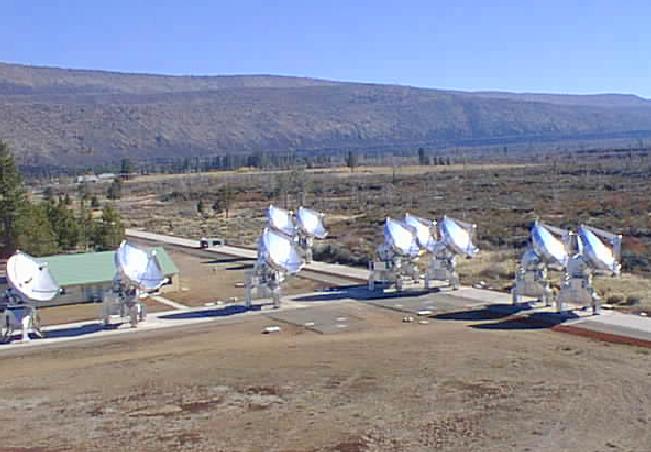
Caption: The Berkeley-Illinois-Maryland (BIMA) array at
Hat Creek, CA, studies the interstellar
medium at millimeter wavelengths.
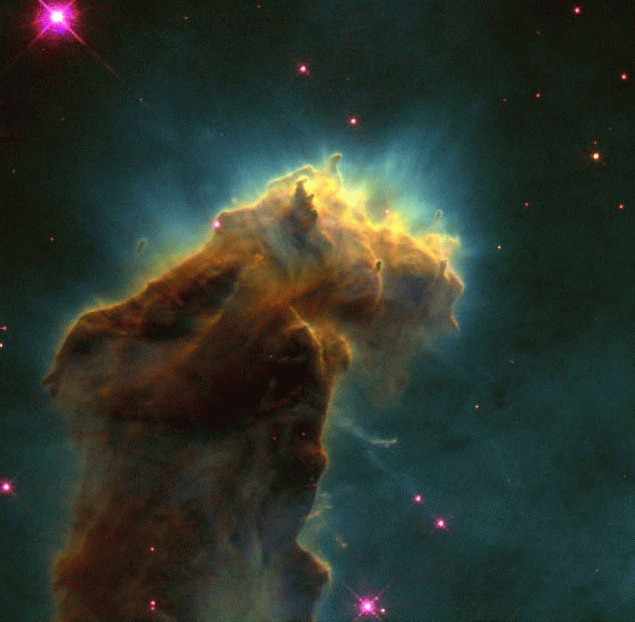
Image courtesy of Hester and Scowen, NASA
Caption: One can see many collapsing cores in
this section of the Eagle Nebula.
There appear to be two different kinds of these dense cores, small ones and big ones. Some molecular clouds contain only small cores, which produce stars of relatively low mass (not much more massive than the Sun). Other clouds are filled with much larger cores, which give rise to stars of both low mass and high mass. As a general rule, clouds producing high-mass stars are much more violent places: the gas within them swirls and churns in a turbulent manner, at speeds of several miles per second. Regions forming only low-mass stars, on the other hand, are relatively calm. What makes a cloud produce only low-mass stars, or a mix of high-mass and low-mass stars? We don't know.
Table of core properties
low-mass cores high-mass cores
--------------------------------------------------------------------
Temperature (K) 10 50 - 100
density (per cm^3) >= 10,000 >= 300,000
total mass (Mcirc ) 1 - 100 2000 - 5000
diameter (pc) 0.2 - 0.6 0.4 - 1.7
stars within usually one usually many
--------------------------------------------------------------------
Note to editor: "Mcirc" above is a capital M with a subscript
of a circle with a dot at the center; that denotes "solar masses.
Why do stars form only inside these dense cores within molecular clouds? To answer this question, we must consider the two major factors acting upon a clump of gas in space: gravity and gas pressure. Gravity pulls material inwards; its force increases with density. The denser a clump is, the stronger the gravitational force on it. Gas pressure is the result of the motion of atoms and molecules in a gas: the faster they move, the harder they knock into each other and push outwards. We describe the speed of particles in a gas by temperature. A gas with a high temperature contains particles moving very fast, and therefore has a high gas pressure.
In order for a clump of gas to collapse into a star, the gravitational force pulling inwards must exceed the gas pressure pushing outwards. This requires a high density of material, to produce a strong gravitational force, and very low temperatures, to yield a small gas pressure. Ordinary clouds of gas in the interstellar medium absorb light from nearby stars, which heats them up, raising their internal pressure and preventing them from collapsing. Molecular clouds, however, are so big and so dense that their outer layers completely block the light from surrounding stars. Deep inside them, temperatures drop so low that the gas pressure becomes very weak. If a small region inside a molecular cloud becomes a little denser than average, the gravitational force exceeds the gas pressure and begins to pull the cloud inwards on itself.
The cores within molecular clouds are regions where gravitational collapse has begun. Once it has started, the process feeds on itself: as the cloud shrinks, it becomes denser ... which increases the gravitational force pulling it inwards ... which causes it to shrink some more ... which increases its density even more ... and so on. We call this a "runaway process." In regions of high-mass star formation, a collapsing core fragments into many pieces, each of which continues to collapse on its own. The collapse will continue until something raises the temperature of the gas enough that the gas pressure balances the gravitational force. In ordinary stars, material continues to collapse until nuclear fusion reactions begin to take place at their centers. Fusion provides enough energy to raise the central temperature to the point that the gas pressure can at last equal the inward force of gravity.
What happens when a new star is born, deep within a molecular cloud? It shines brightly, radiating energy into its immediate surroundings. Recall that temperature is a key to star formation: it is only deep inside molecular clouds, shielded from starlight by light years of opaque gas, that temperatures fall low enough to permit gravitational collapse. When a new star appears inside a cloud, it heats up the surrounding gas, raising its temperature from ten degrees to thousands of degrees. The gas pressure at such high temperatures easily prevents any gravitational collapse. In short, the birth of a new star halts any new clumps from forming in its vicinity.
High-mass stars (above ten solar masses or so) become hot enough to produce a significant number of ultraviolet (UV) photons. Some UV photons have enough energy not only to break apart H2 molecules into individual hydrogen atoms, but also to ionize the hydrogen atoms. Ionized hydrogen, called "HII", glows with a distinctive reddish color. We often see HII regions associated with molecular clouds; in fact, one good way to find molecular clouds is to search for the bright reddish HII regions which appear so clearly in optical photographs of the sky.
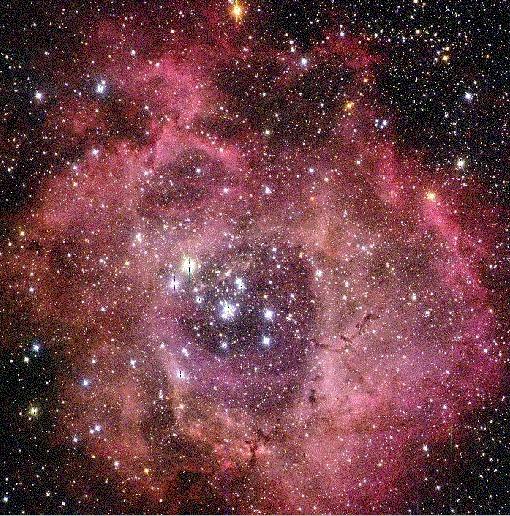
Image courtesy of P. Seitzer (U. Michigan),
Curtis Schmidt Telescope, CTIO, Chile
Caption: Hydrogen gas in the Rosette Nebula, excited
by the hot stars in its central cluster,
glows bright red.
Although new stars do prevent additional clumps of gas from forming in their immediate vicinity, they may indirectly contribute to star formation elsewhere in the cloud. At certain points in their evolution, some stars blow streams of material from their surfaces into the space around them. When these stellar winds run into the surrounding molecular gas, they press it forward, increasing its density. Some high-mass stars explode at the end of their lives, ejecting many solar masses of material outwards at thousands of kilometers per second. This material slams into the ambient molecular gas, sending shock waves through the cloud. The result in both cases is to compress regions of the molecular cloud, which may create clumps of high density. The clumps may become so dense that gravity causes them to collapse, leading to the formation of a second generation of stars. The new stars, in turn, while destroying the gas in their immediate vicinity, may induce more distant portions of the cloud to collapse, forming a third generation of stars. Over tens of millions of years, a series of star-forming episodes can gradually eat into a molecular cloud, and eventually destroy it.

Caption: One generation of hot stars near a molecular cloud
leads to the formation of another.
The Orion Nebula is a beautiful mixture of stars, gas, and dust, bright enough to see with the naked eye. Because it is the closest region of high-mass star formation (only about 450 parsecs from Earth), astronomers have observed it extensively with telescopes covering the electromagnetic spectrum from the radio spectrum to the X-ray. Let's take a tour of the Nebula as an example of star formation in our galaxy.
[ Talking Illustration of Orion here? Or just pretty flat picture? ]
The entire complex we see is only a portion of a giant cloud called Orion Molecular Cloud 1, or OMC-1 for short. One the near side of OMC-1 is a cluster of about 3500 young stars. Most of them are smaller and less massive than the Sun, but a few are much more massive. At the center of the visible Nebula is a quartet of massive stars called "The Trapezium". The biggest and brightest of these four, a star called (note to editor: this should look like "Greek letter theta, with a superscript 1, then Ori C") theta-1 Ori C, has a mass about thirty times that of our Sun, and a temperature about 40,000 K. It produces most of the UV radiation which ionizes the surrounding hydrogen, causing the gas to glow like a fluourescent light bulb. The intense radiation from the Trapezium stars creates a "blister" on the side of the molecular cloud: it heats the molecular gas, increasing its pressure so that the gas blows outwards, away from the cloud.
We believe that the cluster of stars formed from a portion of OMC-1 just a few million years ago. There are several indications that the cluster is very young. First, models of stars as massive as theta-1 Ori C (see note above) indicate that they run out of fuel after only five or six million years. Second, spectra of many of the stars in the cluster show lines of the element lithium, which is destroyed very early in stellar evolution. Third, many of the stars are rotating very quickly; in general, the rotation of stars gradually slows down as they grow older. Finally, many of stars in this cluster emit enough X-rays to appear in pictures taken by the Chandra X-ray satellite. Theoretical models of star formation suggest that X-rays can be produced when stars are surrounded by disks of gas, during a very early phase in their evolution.
In fact, we can actually see circumstellar disks around some of the stars in the Orion Nebula! Images taken by radio telescopes and the Hubble Space Telescope show roughly 150 elongated objects.
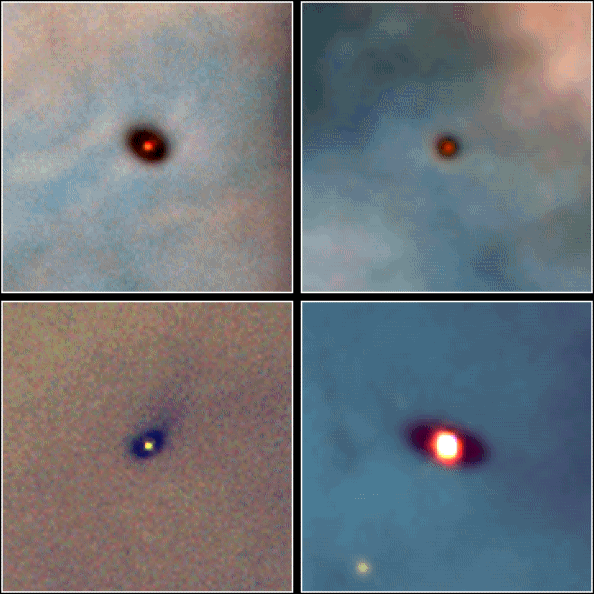
Image courtesy of McCaughrean, O'Dell, NASA
Caption: Close-up images of four proplyds in the Orion Nebula.
These protoplanetary disks, or "proplyds" for short, are somewhat larger than our own planetary system: they extend 100-500 AU from their central stars, compared to 40 AU for Pluto. Some of them appear dark, in silhouette against the bright background of the Nebula. Others look bright, because their gas is excited by the radiation from theta-1 Ori C (see note above). A few of the proplyds show jets of material. Over the next few hundred thousand years, these disks of gas will disappear: most if the material, heated both by the central object and the Trapezium stars, will evaporate into the general nebulosity, but some of the gas may form planets.
Although we cannot see them directly, we suspect that there are two additional regions of star formation within OMC-1. Radio telescopes reveal knots of ionized gas and jets of material in two different sections of the molecular cloud, most likely due to very young protostars. It is possible that winds and shocks from the visible cluster of stars has triggered the collapse of material deeper within the molecular cloud. If we were to look at the Orion Nebula in ten million years, we would see most of the current cluster of stars (surrounded by a less luminous bubble of glowing gas, since the most massive stars would have disappeared), plus two new clusters, each within its own bubble of ionized hydrogen.
 Copyright © Michael Richmond.
This work is licensed under a Creative Commons License.
Copyright © Michael Richmond.
This work is licensed under a Creative Commons License.